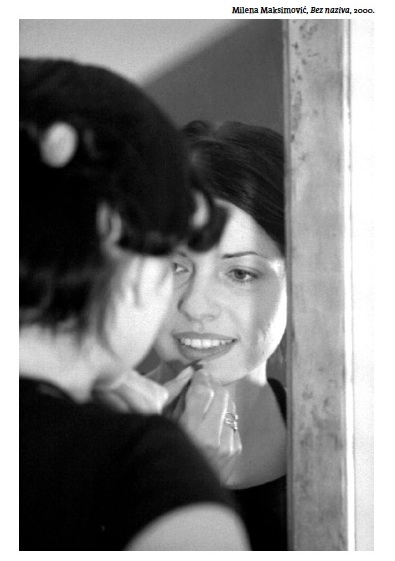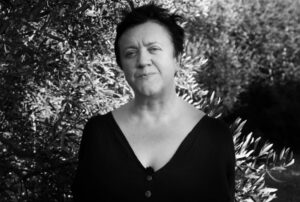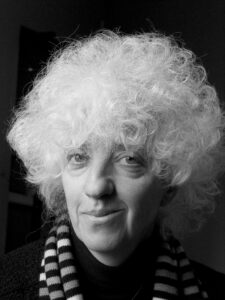Milena Maksimović

– was born in 1976 in Pančevo, where she died prematurely in 2014. Graduated from the Polytechnic School for Graphic Design in 1998. Attended courses at alternative Belgrade schools (Women’s Studies and School of Art History and Theory – CSUB). She participated in the Kaleidoscope photography workshop. She had eight solo exhibitions and exhibited at more than 35 group exhibitions in the country and abroad. Her photos were published in the promotional material of the campaign “Quality education for all” – VelikiMali (BigSmall), Pančevo; the brochure “Culture is written with the heart” of the Ministry of Culture and Information of the Republic of Serbia, as well as in the daily press and professional periodicals (Literaturen, 3+4, Prelom, Manuscripts, Ludus, Vreme, Pančevac, Pančevo Monograph). She is the author of the ecological photo campaign ECO-PA in cooperation with the weekly Pančevac and the multimedia project MAPA Mapping of Pančevo. She is the winner of Salon 02 Pančevo in 2002 and Salon 05 Pančevo in 2005.
Self-portrait published in Prelom – journal for theory and contemporary art, Vol 1, 2001, courtesy of family Maksimović.
Milena Maksimović often tried to find answers to the world’s problems within herself, which is not so atypical for the generations born in the mid-seventies. “I wonder what it is in me that doesn’t allow me to breathe, what is it in me?” – she said on a hot August day in 2013. She left us on March 8, a year later, she went on Women’s Day.
Her early video 2 23 76 focuses on the intimate relationship between the artist and her grandmother, entangled in an expansive web of identity and image production and consumption. The artist films her grandmother, who suffers from dementia, while sitting motionless in front of the TV screen – an action that is repeated every day and lasts almost the whole day. In the next session, she plays her own recordings instead of the TV program so that the grandmother encounters herself on the screen. The moment she sees her own image on TV, the grandmother begins to construct a fictional narrative about her previous life as an actress, perceiving the presence of the camera in the house as a television interview. From that new, imagined perspective, she claims that she worked on the film with the famous Yugoslav actors Mija and Čkalja, but also with the seven dwarfs. Acting becomes synonymous with everything she has ever experienced, including the pastry business that was her actual occupation.
The most exhibited work by Milena Maksimović was created within the framework of the Yugoslav Biennial of Young Artists in Vršac in 2004 – the photo series One-Way Ticket12345 – a dense tableau-vivant of people and goods, an image of the global circulation of bodies and objects.
Milena wrote about the social background of these images:
“Chinese citizens started coming to Yugoslavia en masse in 1997, after the former president of the FRY, Slobodan Milošević, visited China. His influential wife, Mira Marković, launched the idea of a “Chinatown” in Belgrade, in the spirit of a metropolis. Although, according to the free media estimates, around 40,000 Chinese live in Serbia today, Belgrade has not yet become a metropolis. The Belgrade newspaper Večernje Novosti, however, states that all the inhabitants of the Chinese village of King Tiu, in Zhejiang province, have moved to Belgrade! More precisely, they all settled in the New Belgrade’s Block 70, where they sell cheap consumer goods, while the Chinese village, as its former residents claim, remained deserted. Some of them were paid one-way train tickets just to move out of China, but the majority migrated to these areas “because there are more opportunities in Serbia than in China”. The issue of opportunities is, of course, always ambivalent and projective, and the issue of the daily life of the Chinese community in Belgrade is permeated with various forms of class, racial and legal exclusion.”
BACK UP (2005) is an exhibition of a series of intimate photographs of home production, created in the period 2002-2003, in which the artist was ill and isolated in her house. The photos were taken without aesthetic pretensions and without the intention of being exhibited in public. They are stored in a computer file, without any special purpose or intention.
In many ways, the scenes we see here give the impression of accidental triggers, cold observations and lazy examinations – drops of moisture on the window, the texture of the wall, a stain on a medical document typed on a typewriter, creases on the bedding, the play of light6789. These are the scenes that we rather stare at than look at, scenes that reveal through concealment, that point us to the (absent) object itself through images of “averted gazes”, a self-portrait of a photographer who refuses to expose herself to the lens. Milena is reflecting the conclusions of Susan Sontag and her book Illness as Metaphor, where she writes about the socially oppressive idea that the illness portrays an individual and fits “metaphorically” true to him/her, just as sin fits a sinner. Sontag also writes about the silencing and tabooing of the word cancer outside of a metaphorical context.
We can see this series of photographs as a specific “psychogeographic research”, where it geographically covers the confined space of the patient’s room. Seemingly aimless wandering with a photographic camera within this microcosm acquires the attribute “political” only through displacement from a remote computer file and intolerable enlargement in the public space, through the charting of the heterotopic – a place of distinction and irregularity. Thus, we read the actions of Milena Maksimović through the politics of everyday life, which place the oppressed subjectivities in the sphere of interest and oppose the normative, hegemonic and homogenous concept of the public.
Text is written by Jelena Vesić (2022).
1Image: Milena Maksimović, One Way Ticket, photo-series, 2004, courtesy of family Maksimović.2Image: Milena Maksimović, One Way Ticket, photo-series, 2004, courtesy of family Maksimović.
3Image: Milena Maksimović, One Way Ticket, photo-series, 2004, courtesy of family Maksimović.
4Image: Milena Maksimović, One Way Ticket, photo-series, 2004, courtesy of family Maksimović.
5Image: Milena Maksimović, One Way Ticket, photo-series, 2004, courtesy of family Maksimović.
6Image: Milena Maksimović, Back Up, Gallery Artget, KCB, 2005, courtesy of family Maksimović.
7Image: Milena Maksimović, Back Up, Gallery Artget, KCB, 2005, courtesy of family Maksimović.
8Image: Milena Maksimović, Back Up, Gallery Artget, KCB, 2005, courtesy of family Maksimović.
9Image: Milena Maksimović, Back Up, Gallery Artget, KCB, 2005, courtesy of family Maksimović.
– rođena 1976. godine u Pančevu, gde je i prerano preminula 2014. godine. Diplomirala na Višoj Politehničkoj školi grafički dizajn 1998. godine. Pohađala je kurseve na alternativnim beogradskim školama (Ženske studije i Škola za istoriju i teoriju umetnosti CSUB). Učestvovala je u radu fotografske radionice Kaleidoskop. Priredila je osam samostalnih izložbi i izlagala na više od 35 grupnih izložbi u zemlji i inostranstvu.
Objavila je fotografije u promotivnom materijalu kampanje “Kvalitetno obrazovanje za sve” – VelikiMali, Pančevo; brošuri “Kultura se piše srcem” Ministarstva kulture Republike Srbije kao i u dnevnoj štampi i stručnoj periodici (Literaturen, 3+4, Prelom, Rukopisi, Ludus, Vreme, Pančevac, Monografija Pančeva). Autorka ekološke foto-kampanje EKO-PA u saradnji sa nedeljnikom Pančevac i multimedijalnim projektom MAPA Mapiranje Pančeva. Dobitnica je nagrada Salona 02 Pančeva, 2002. godine i Salona 05 Pančeva, 2005.
Autoportret objavljen u časopisu Prelom br 1, 2001, ljubaznošću porodice Maksimović.
Milena Maksimović je često pokušavala da u sebi nađe odgovore za probleme sveta, što nije tako netipično za generacije rođene sredinom sedamdesetih godina. “Pitam se šta je to u meni što mi ne dozvoljava da dišem, šta je to u meni?” – rekla je vrelog avgustovskog dana 2013. Napustila nas je 8. marta godinu dana kasnije, otišla je na Dan žena.
Njen rani video 23 2 76 postavlja u fokus intimni odnos umetnice i njene bake, upleten u ekspanzivnu mrežu proizvodnje i potrošnje identiteta i slika. Umetnica snima video kamerom svoju baku koja pati od demencije, dok nepomično sedi ispred TV ekrana – radnju koja se svakodnevno ponavlja i traje gotovo čitav dan. U sledećoj seansi pušta sopstvene snimke umesto TV programa tako da se baka susreće sa samom sobom na ekranskoj slici. U trenutku kada ugleda svoju sliku na TV-u, baka počinje da gradi izmišljeni narativ o svom prethodnom glumačkom životu, doživljavajući prisustvo kamere u kući kao televizijski intervju. Iz te nove, izmaštane perspektive, ona tvrdi kako je radila na filmu sa poznatim jugoslovenskim glumcima “Mijom i Čkaljom”, ali takođe i sa sedam patuljaka. Gluma postaje sinonim za sve što je ikada proživljavala, uključujući i poslastičarski posao koji je bio njeno aktualno zanimanje.
Najviše izlagan rad Milene Maksimović je nastao u okviru Jugoslovenskog bijenala mladih umetnika u Vršcu 2004 godine – serija fotografija Karta u jednom pravcu12345 – gusti tableau-vivant ljudi i robe, slika globalne cirkulacije tela i predmeta.
O društvenoj pozadini ovih slika Milena je napisala:
„Kineski državljani počinju da masovno dolaze u Jugoslaviju 1997. godine, nakon što je bivši predsednik SRJ, Slobodan Milošević, posetio Kinu. Njegova uticajna supruga Mira Marković, lansirala je ideju o »Kineskoj četvrti« u Beogradu, u duhu svetske prestonice., Iako danas u Srbiji po slobodnim procenama medija živi oko 40.000 Kineza, Beograd još uvek nije postao svetska prestonica. Beogradski list Večernje novosti međutim, navodi da su se svi stanovnici kineskog sela King Tiu, u provinciji Zhejiang, preselili u Beograd! Tačnije, svi su se smestili u novobeogradski blok 70, gde prodaju jeftinu robu široke potrošnje, dok je kinesko selo, kako tvrde njegovi bivši stanovnici, ostalo pusto. Nekima od njih su plaćene vozne karte u jednom pravcu samo da se isele iz Kine, ali je većina migrirala na ove prostore »jer u Srbiji ima više mogućnosti nego u Kini«. Pitanje mogućnosti je, naravno, uvek ambivalentno i projektivno, a pitanje svakonevnog života kineske zajednice u Beogradu prožeto je različitim oblicima klasne, rasne i pravne izopštenosti.“
BACK UP (2005) je izložba serije intimnih fotografija kućne produkcije, nastalih u periodu 2002-2003, u kojem je umetnica bila bolesna i izolovana u svojoj kući. Fotografije su snimljene bez estetskih pretenzija i bez namere da budu izložene u javnom prostoru. Odlagane u kompjuterski fajl, bez posebne namene i namere.
Prizori koje ovde vidimo po mnogo čemu ostavljaju utisak slučajnih okidanja, hladnih konstatacija i dokoličarskih proučavanja – kapljice vlage na prozoru, faktura zida, fleka na medicinskom dokumentu iskucanom na pisaćoj mašini, nabori na posteljini, igra svetlosti6789. To su prizori u koje radije zurimo nego što ih gledamo, prizori koji otkrivaju kroz skrivanje, koji nas upućuju na sâm (odsutni) objekt kroz slike “odvraćenih pogleda”. Reč je o nekoj vrsti autoportreta fotografkinje koja odbija da se izloži objektivu, reflektujući zaključke Susan Sontag i njene knjige Bolest kao metafora, koja piše o društveno opresivnoj ideji prema kojoj bolest portretiše pojedinca i stoji mu „metaforički“ istinito, baš kao što grešniku stoji greh. Sontag takođe piše o prećutkivanju i tabuizaciji reči rak (kancer) izvan metaforičkog konteksta.
Ovu seriju fotografija možemo sagledati kao specifična “psihogeografska istraživanja”, gde geografsko obuhvata skučeni prostor bolesničke sobe. Naizgled besciljno lutanje fotografskim aparatom unutar ovog mikrosveta dobija atribut “političko” tek kroz izmeštanje iz zabačenog kompjuterskog fajla i nesnosno uvećanje u javnom prostoru, kroz ucrtavanje heterotopskog – mesta razlikovanja i nepravilnosti. Tako delovanje Milene Maksimović čitamo kroz politike svakodnevnog života koje postavljaju potlačene subjektivnosti u sferu interesovanja i suprotstavljaju se normativnom, hegemonom i homogenom pojmu javnosti.
Tekst je napisala Jelena Vesić (2022).
1Slika: Milena Maksimović, One Way Ticket, serija fotografija, 2004, ljubaznošću porodice Maksimović.2Slika: Milena Maksimović, One Way Ticket, serija fotografija, 2004, ljubaznošću porodice Maksimović.
3Slika: Milena Maksimović, One Way Ticket, serija fotografija, 2004, ljubaznošću porodice Maksimović.
4Slika: Milena Maksimović, One Way Ticket, serija fotografija, 2004, ljubaznošću porodice Maksimović.
5Slika: Milena Maksimović, One Way Ticket, serija fotografija, 2004, ljubaznošću porodice Maksimović.
6Slika: Milena Maksimović, Back Up, Gallery Artget, KCB, 2005, ljubaznošću porodice Maksimović.
7Slika: Milena Maksimović, Back Up, Gallery Artget, KCB, 2005, ljubaznošću porodice Maksimović.
8Slika: Milena Maksimović, Back Up, Gallery Artget, KCB, 2005, ljubaznošću porodice Maksimović.
9Slika: Milena Maksimović, Back Up, Gallery Artget, KCB, 2005, ljubaznošću porodice Maksimović.



